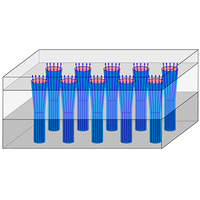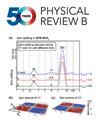用电超晶格和磁超晶格诱导双层石墨烯中的拓扑扁带
IF 3.7
2区 物理与天体物理
Q1 Physics and Astronomy
引用次数: 0
摘要
最近有人提出,暴露在二维超晶格(SL)电势下的贝纳尔堆叠双层石墨烯(BLG)会表现出各种有趣的行为[Ghorashi 等人,Phys.其中最主要的是出现平坦的切尔带,这有利于分数切尔绝缘体态的出现。在这里,我们探讨了将空间周期性平面外轨道磁场应用到 Ghorashi 等人的模型中,以寻找诱导平坦切尔带的其他方法。我们重点研究的磁场的长度尺度远大于 BLG 中的原子间距,从而产生我们所说的磁性 SL。我们研究的磁性 SL 要么没有向 SL 单元引入净磁通量,要么只有单量子磁通量。我们发现,磁性 SLs 本身可以诱导拓扑平坦带,但当磁性 SLs 与相称的电性 SLs 共同作用时,可以观察到更丰富的行为,例如出现具有高切尔数的平坦带和通用带。最后,我们提出了一种生成单位流量子磁SL和相应电SL的方法。磁SL是由源于II型超导体的磁通漩涡周期性阵列产生的,而电SL则是由于磁SL在磁电材料表面引起的电荷密度而产生的。调节涡流晶格和磁电耦合可以控制这两种 SL,我们还研究了它们对 BLG 带状结构的影响。本文章由计算机程序翻译,如有差异,请以英文原文为准。

Inducing topological flat bands in bilayer graphene with electric and magnetic superlattices
It was recently argued that Bernal stacked bilayer graphene (BLG) exposed to a two-dimensional superlattice (SL) potential exhibits a variety of intriguing behaviors [Ghorashi et al., Phys. Rev. Lett. 130, 196201 (2023)]. Chief among them is the appearance of flat Chern bands that are favorable to the appearance of fractional Chern insulator states. Here, we explore the application of spatially periodic out-of-plane orbital magnetic fields to the model of Ghorashi et al. to find additional means of inducing flat Chern bands. We focus on fields that vary on length scales much larger than the atomic spacing in BLG, generating what we refer to as magnetic SLs. The magnetic SLs we investigate either introduce no net magnetic flux to the SL unit cell or a single quantum of flux. We find that magnetic SLs acting on their own can induce topological flat bands, but richer behavior, such as the appearance of flat and generic bands with high Chern numbers, can be observed when the magnetic SLs act in conjunction with commensurate electric SLs. Finally, we propose a method of generating unit-flux-quantum magnetic SLs along with concomitant electric SLs. The magnetic SL is generated by periodic arrays of flux vortices originating from type II superconductors, while the electric SL arises due to a magnetic SL-induced charge density on the surface of a magnetoelectric material. Tuning the vortex lattice and the magnetoelectric coupling permits control of both SLs, and we study their effects on the band structure of BLG.
求助全文
通过发布文献求助,成功后即可免费获取论文全文。
去求助
来源期刊

Physical Review B
物理-物理:凝聚态物理
CiteScore
6.70
自引率
32.40%
发文量
0
审稿时长
3.0 months
期刊介绍:
Physical Review B (PRB) is the world’s largest dedicated physics journal, publishing approximately 100 new, high-quality papers each week. The most highly cited journal in condensed matter physics, PRB provides outstanding depth and breadth of coverage, combined with unrivaled context and background for ongoing research by scientists worldwide.
PRB covers the full range of condensed matter, materials physics, and related subfields, including:
-Structure and phase transitions
-Ferroelectrics and multiferroics
-Disordered systems and alloys
-Magnetism
-Superconductivity
-Electronic structure, photonics, and metamaterials
-Semiconductors and mesoscopic systems
-Surfaces, nanoscience, and two-dimensional materials
-Topological states of matter
 求助内容:
求助内容: 应助结果提醒方式:
应助结果提醒方式:


